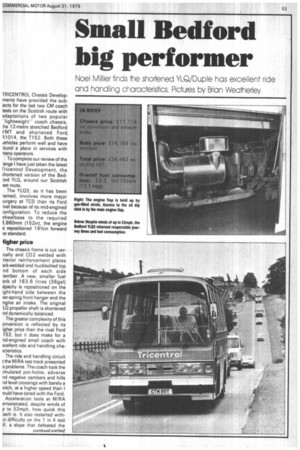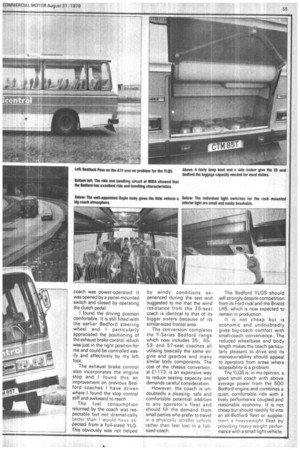Small Bedford big performer
Page 55

Page 56

Page 57

If you've noticed an error in this article please click here to report it so we can fix it.
Noel Millier finds the shortened YLQ/Duple has excellent ride and handling characteristics. Pictures by Brian Wea-nerley.
TRICENTROL Chassis Developments have provided the subjects for the last two CM coach tests on the Scottish route with adaptations of two popular 'lightweight' coach chassis, :he 12-metre stretched Bedford t'MT and shortened Ford. R1014, the T152. Both these vehicles perform well and have 'ound a place in services with rany operators.
To complete our review of the -ange I have just taken the latest fricentrol Development, the ;hortened version of the Bedord YLQ, around our Scottish est route.
The YLQS, as it has been lamed, involves more major iurgery at TCD than its Ford ival because of its mid-engined ;onfiguration. To reduce the vheelbase to the required 3,860mm (152in), the engine s repositioned 191/2in forward or standard.
iigher price
The chassis frame is cut vertally and CO2 welded with iterior reinforcement plates ack-welded and huckbolted top nd bottom of each side iember. A new, smaller fuel 3nk of 163.6 litres (36ga1) apacity is repositioned on the ight-hand side between the .ar-spring front hanger and the ngine air intake. The original LO propeller shaft is shortened rid dynamically balanced.
The greater complexity of this onversion is reflected by its igher price than the rival Ford 152, but it does make for a lid-engined small coach with xcellent ride and handling chaicteristics.
The ride and handling circuit t the MIRA test track presented o problems. The coach took the Imulated pot-holes, adverse nd negative cambers and hills rid level crossings with barely a vitch, at a higher speed than I
u I d have dared with the Ford. Acceleration tests at MIRA emonstrated, despite winds of
p to 52mph, how quick this )ach is. It also restarted with
Jt on the 1 in 4 test ill, a slope that defeated the
Ford T152. The little Bedford managed to climb the 1 in 3 test hill although I decided not to attempt a restart test on this hill. The park brake did hold on the descent of the 1 in 3 slope.
The brakes proved more than adequate during braking tests and on the road and at times seem just a little violent for ordinary use. But I got used to them quite soon and, with the aid of the exhaust brake, gave my load of simulated passengers a smooth ride.
On the road section of the test I enjoyed driving this coach. Cruising at 110km / h (70mph) on motorways was normally possible on all but the major uphill stretches, despite particularly windy conditions. The coach climbed Shap on the M6 in top gear at speeds of between 72 and 80km /h (45 and 50mph) with no trouble at all.
On the non-motorway sec tions, the coach comfortably held 80km /h (50mph) and the driver had to keep a grip on himself to stay within the legal speed limits.
Despite numerous diversions and delays caused by accidents to other vehicles, roadworks, holiday and agricultural traffic, the coach returned respectable journey times.
Like the two Tricentrol conversions previously tested, the YLQS was fitted with a Duple Dominant 2 body. The test coach, which was the first conversion to be carried out on the YLQ chassis, was from the Dunstable-based fleet of Tricentrol coaches and has been in service since early this year. Among the extras fitted the body were full draw curtains and armrests on the 35 seats. Duties for the coach, which has proved popular with drivers and passengers, have included tours of the Rhine Valley.
I found the ride of the YLQS as good as any steel-sprung coach and better than most. The noise level inside the coach was low and although the engine is in the middle, the noisiest part of the coach was the front where wind noise was noticeable. The Duple body was well appointed, rattleand creak-free and well finished. Armrests on the seats, curtains and magazine holders on the seat-backs gave the vehicle a luxurious air. My only criticism of the Duple body concerned a very minor point. The interior lights fitted to the luggage racks are controlled by individual, awkward, small and easily breakable switches.
One useful extra is the pavement window on the passenger door. This is an option I usually notice when it is not fitted — which argues a need for it.
The entrance door on the test coach was power-operated. It was opened by a panel-mounted switch and closed by operating the clutch pedal.
I found the driving position comfortable. It is still fitted with the earlier Bedford steering .wheel and I particularly appreciated the positioning of the exhaust brake control, which was just in the right position for me and could be controlled easily and effectively by my left foot.
The exhaust brake control also incorporates the engine stop and I found this an improvement on previous Bedford coaches I have driven where I found the stop control stiff and awkward to reach
The fuel consumption returned by the coach was respectable but not dramatically better than I would have expected from a full-sized YLQ. This obviously was not helped
by windy conditions experienced during the test and suggested to me that the wind resistance from the 35-seat coach is identical to that of its ' bigger sisters because of its similar-sized frontal area.
The conversion completes the Y-Series Bedford range which now includes 35-, 45-, 53and 57-seat coaches all utilising basically the same engine and gearbox and many similar body components. The cost of the chassis conversion, at El 173, is an expensive way to reduce seating capacity anci demands careful consideration.
However, the coach is undoubtedly a pleasing, safe and comfortable potential addition to any operator's fleet arid should fill the demand from small parties who prefer to travel in a physically smaller vehicle rather than feel lost in a fullsized coach. The Bedford YLQS should sell strongly despite competition from its Ford rival and the Bristol LHS, which is now expected to remain in production.
It is not cheap but is economic and undoubtedly gives big-coach comfort with small-coach convenience. The reduced wheelbase and body length makes the coach particularly pleasant to drive and its manoeuvrability should appeal to operators from areas where accessibility is a problem.
The YLQS is, in my opinion, a good small coach with above average power from the 500 Bedford engine and combines a quiet, comfortable ride with a lively performance coupled and reasonable economy It is not cheap but should readily fit into an all-Bedford fleet or supplement a heavyweight fleet by providing heavy-weight performance with a small light vehicle.




































































































